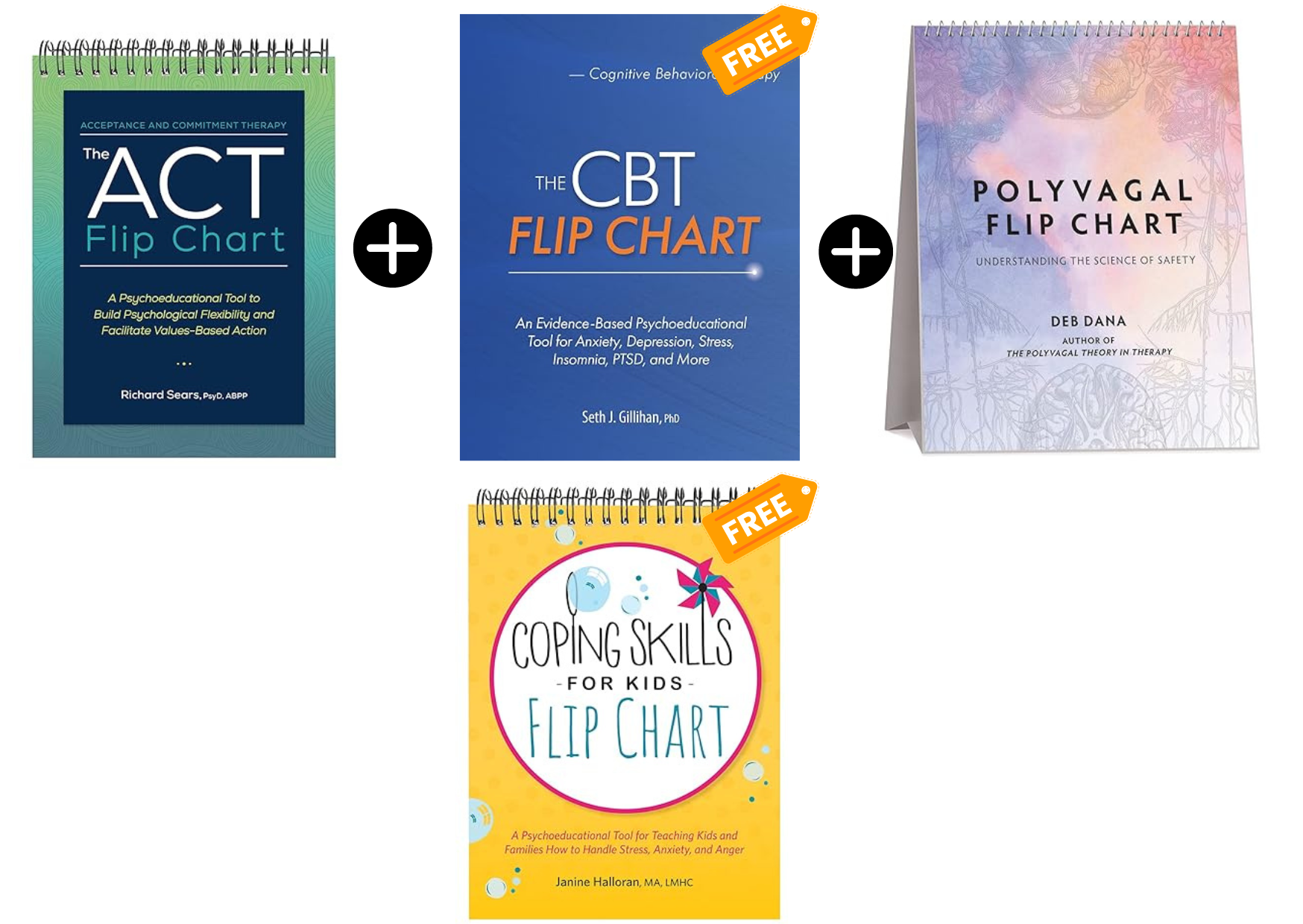Description
The CBT Flip Chart: Evidence-Based Treatment for Anxiety, Depression, Insomnia, Stress, PTSD, and More
Mindfulness-centered cognitive behavioral therapy (CBT) offers a powerful set of practices that offers relief from common conditions like anxiety and depression. In The CBT Flip Chart, clinicians will find a straightforward and easy-to-understand resource that makes it easier to share these practices with clients. Intended for use in sessions, this simple, user-friendly format includes:
27 full-color diagrams on client-facing pages
Additional explanations and examples on each corresponding therapist-facing page
This digital edition is designed for use in telehealth. To allow you to screenshare the client pages while viewing the therapist pages on a separate screen or device, an additional copy of the client-facing material is available for purchasers to download (details are included inside). You can use the digital markup tools found in your ebook reading app or telehealth platform to emphasize key points or fill in client responses on these pages.
With The CBT Flip Chart, clients will learn the fundamental concepts of mindfulness-centered CBT, such as:
The interconnections among thoughts, feelings, and behavior
Cognitive distortions
Behavioral activation
Exposure therapy
Mindfulness in daily activities
The pages that follow demonstrate how CBT is used in the treatment of specific conditions your clients are facing, including:
Overwhelming stress
Depression
Worry
Procrastination
Social anxiety
Panic
Posttraumatic stress disorder (PTSD)
Obsessive-compulsive disorder (OCD)
Problematic anger
Insomnia
Novice and seasoned CBT therapists alike will enjoy the confidence and ease that The CBT Flip Chart offers for bringing these powerful practices to their clients.
Table of Contents
Section 1: Understanding Think Act Be
What Is CBT?
The CBT Model
Setting Goals
THINK: Cognitive Techniques
Examining Thoughts
Cognitive Distortions
Core Beliefs
ACT: Behavioral Techniques
Behavioral Activation Part 1
Behavioral Activation Part 2
Maximizing Follow-Through
Exposure Therapy
BE: Mindfulness Techniques
What Is Mindfulness?
Benefits of Mindfulness
Mindfulness in Action
Meditation
Being the Observer
Section 2: Applying Think Act Be
Stress Management Part 1: Recognizing Stress
Stress Management Part 2: Reducing Stress
Depression
Worry
Procrastination
Social Anxiety
Panic
Post-Traumatic Stress Disorder (PTSD)
Obsessive-Compulsive Disorder (OCD)
Problematic Anger
Insomnia
Maintaining Gains.
The ACT Flip Chart: A Psychoeducational Tool to Build Psychological Flexibility and Facilitate Values-Based Action
Acceptance and commitment therapy (ACT) provides a powerful framework for getting clients unstuck and helping them live a more meaningful, values-guided life.
In The ACT Flip Chart, clinicians will find a variety of interactive tools and exercises that bring the six core elements of ACT to life:
Self-as-context
Defusion
Experiential acceptance
Present-moment awareness
Values
Committed action
The chart’s engaging and easy-to-use nature makes it ideal for helping clients to:
Develop psychological flexibility
Let go of ineffective behaviors
Connect with their values
Become more present and aware
Relate differently to distressing thoughts and difficult emotions
Take values-based action in the face of discomfort.
Polyvagal Flip Chart: Understanding the Science of Safety (Norton Series on Interpersonal Neurobiology)
Offers therapists a low tech–high impact, interactive way to explain polyvagal theory to clients.
When clients are stuck in the cognitive experience of their story, an explanation of polyvagal theory helps to bring their attention to the autonomic experience― to bring the importance of the biology of their experience back into awareness. Yet polyvagal theory can be challenging and intimidating to explain.
This flip chart offers therapists an easy, standardized way to support clients in understanding the role of the autonomic nervous system in their lives. Using a flip chart makes psycho-education an interactive experience. Therapists can feel confident in teaching their clients polyvagal theory by following the chart.
With a flip chart visible during sessions, the therapist can:
remind clients of the ways the autonomic nervous system has been shaped and is active in their daily living experience,
display a page corresponding to the present moment, thus anchoring that experience in the theory,
keep a page of the hierarchy visible when working with a client’s habitual response pattern.
Color illustrations throughout
Coping Skills for Kids Flip Chart: A Psychoeducational Tool for Teaching Kids and Families How to Handle Stress, Anxiety, and Anger.
Therapist Approved! Psychoeducational flip charts are a unique and reusable in-session therapy tool that bring clinical concepts to life.
Buy it once, use it hundreds of times!
Looking for a fun, hands-on way to teach kids about coping skills?
The Coping Skills for Kids Flip Chart is a colorful, interactive tool that therapists and other professionals can use to help kids explore their coping style and learn to handle stress in safe and healthy ways.
Fully illustrated with a variety of kid-friendly designs, this psychoeducational in-session tool turns learning into a dynamic and engaging skill-building experience.
Ideal for use with individuals, groups, classrooms, and families, this chart teaches kids how to work through even the trickiest of feelings by focusing on five core areas of coping:
Relaxation
Distraction
Movement
Sensory
Processing
Each intervention includes a full-color client-facing page and a corresponding therapist-facing page with guidance and tips to bring the intervention to life. What’s more, each client-facing page is on a dry-erase surface so you can use them over and over!





Reviews
There are no reviews yet.